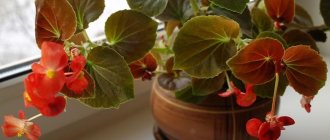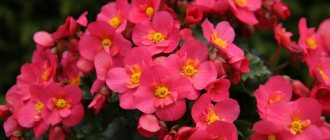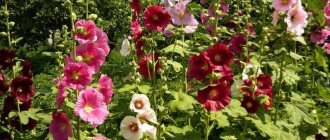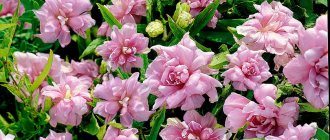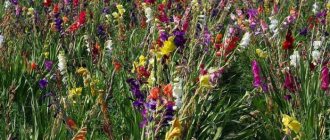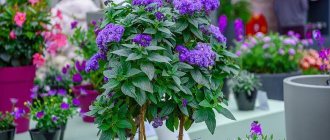In the article we will talk about the features of terry begonia, its types, and most importantly, how to properly care for it at home.
This beautifully flowering shrub from the Begoniaceae genus has numerous carved leaves and large flowers reminiscent of small roses. The petals have a terry border at the tips, which explains the name of this flower.
Botanical description
The plant began to be grown indoors in the 17th century. The natural habitat is quite extensive - it grows in the vast expanses of Asia, Africa and America.
Currently, a lot of different varieties have been bred, differing in the shape and size of flowers, their color and cultivation characteristics. A popular variety available for sale is considered “Terry Mix Begonia ,” which is available in several colors.
As the begonia grows, it develops two unisexual flowers – male and female. Male buds have double petals, while female buds perform the function of reproduction - a seed pod is formed on them.
Most varieties feel great in open ground, where plants can be planted in late spring. With its flowering, terry begonia can delight the entire warm period, and sometimes even in winter.
Benefits of the plant
- Begonias bloom profusely throughout the summer until the first frost.
- Grows well in sun and partial shade.
- The choice between the available varieties is so great that you can choose between many interesting flower colors and different shapes, reaching from 10 to 30-35 cm in height, with straight or drooping stems.
- The flower can be grown in flower beds, in pots, containers, decorating terraces and balconies.
- Ready-made seedlings are widely available for sale in the spring.
- Young plants can be grown without problems at home on a windowsill by planting tubers bought in a store or stored from the previous season in early spring.
Titles and photos
Terry begonia is represented by numerous subspecies, each of which has its own distinctive characteristics. Below are photos and descriptions of terry begonia varieties suitable for propagation and care at home.
Yellow
It is a small bush with recumbent, highly branching shoots, distinguished by the yellow color of the inflorescences. The flowers of yellow begonia are quite large - up to 4 cm in diameter and consist of many petals. The leaves are medium (up to 20 cm in length). The height of this variety does not exceed 50 cm. Among the popular varieties of this variety are:
- Picoti;
- Full yellow;
- Ampelous Cascade yellow (Pendula).
Red
It has red lush flowers up to 10 cm in diameter and patterned bronze leaves. The height of the plant is approximately 20-30 cm. Red begonia blooms from May to October. At the same time, you can enjoy the beauty of its flowers for 2-4 weeks. The photo below shows a red terry begonia:
Pink
Differs from other varieties with pink inflorescences. Reaches half a meter in height and is often used for planting in open ground. Pink begonia feels great in a well-lit flowerbed and, with enough fertilizer, will bloom luxuriantly from May to October . Look at the photo below to see what the terry pink variety looks like:
Scarlet
This subspecies has rich burgundy-red flowers with lush fringe along the edges and large leaves of a bronze hue. This variety looks very advantageous in a composition with other flowers, contrasting brightly against the general background. The photo below shows the terry Scarlet variety:
White
White begonia looks very delicate and elegant. The height can reach 25-30 cm. White flowers with corrugated petals are very voluminous - 10-12 cm in diameter. They have a pleasant sweet aroma. Flowering duration is 2-3 weeks.
Is it necessary to fertilize tuberous Begonia?
The tuberous Begonia flower requires certain fertilizer and feeding. As a rule, the plant is first fertilized in the spring. To do this, use fertilizers that contain nitrogen in large quantities. It is enough to make 1-2 feedings with breaks of 7-10 days. Then after a week you can start feeding the plant with potassium fertilizer.
It is enough to make 2-3 feedings with breaks of 10-14 days. During the flowering period, indoor Begonia must be fed with special complex fertilizers for this type of plant.
Care
You can get a healthy, beautifully flowering plant only by following certain rules for caring for it. We'll talk about them further.
Location and lighting
Begonia is photophilous, and therefore it needs additional lighting in the cold season. In hot weather, the flower should be protected from direct sunlight , the contact of which on the leaves can cause burns and overheating.
For symmetrical growth of the bush, the pot with begonia must be periodically rotated 180 degrees.
Watering and humidity requirements
During the period of active growth - spring and summer, the plant needs abundant watering - twice a week. In winter, you need to reduce the number of waterings by about 1.5 times.
Excessive watering can lead to the death of the plant, so make sure that the top layer of soil dries out.
Because
The tap water is too hard ; for irrigation, use settled water at room temperature.
The terry beauty will delight you with its beauty if you provide it with the necessary air humidity. For these purposes, you can use a humidifier or spray the air around the plant, preventing droplets from getting on the leaves and flowers.
A container of water located next to the pot will also help achieve the desired result.
Temperature
Terry begonia prefers an average temperature of 18-23 degrees in summer and not lower than 15 degrees in winter. The flower pot should be ventilated periodically, while protecting it from drafts and sudden changes.
Top dressing
The plant needs to be fertilized during the warm period - spring and summer, because... It is at this time that it needs additional support. Fertilizing should be done no more than 1-2 times a month . This will be enough for the full growth and strengthening of the health of the flower.
In the summer, it is better to use potassium and phosphorus fertilizers, and after winter awakening, nitrogen fertilizers.
The solution for feeding begonias should be diluted more than indicated on the package, because the flower reacts sensitively to an excess of fertilizers.
Transfer
Transplantation depends on the growth rate of the flower - if there is not enough space, it should be placed in a pot of larger diameter. Typically, replanting is carried out every two years in early spring . Tuberous varieties must be replanted annually after wintering.
Soil composition and pot
To keep begonias, it is better to purchase a clay pot with drainage holes at the bottom, which will provide oxygen access to the roots of the flower.
The plant prefers loose, slightly acidic soil with sufficient fertilizer.
You can prepare the soil yourself by including in its composition:
- 2 parts leaf soil;
- 1 part humus;
- 1 part river sand;
- 1 part peat.
If you can’t make the soil mixture yourself, you can buy a ready-made one in the store.
The plant needs a drainage layer, which must be placed at the bottom of a pot made of expanded clay or broken brick.
Frequency of pruning
It is necessary to prune when the main stem reaches 10 cm in length . It is pinched, thereby ensuring the growth of side shoots. The latter are also subject to pruning upon reaching 10-12 cm. Subsequent pruning is carried out only as needed and to give the bush the desired shape.
Watering tuberous Begonia
Tuberous begonia needs systematic moderate watering. Before watering the flower, it is worth settling the water and it should be at room temperature. When watering, do not allow water to get on the leaves or flowers.
Water should be poured along the wall of the flower pot; if water remains in the stand, then it must be poured out so that fungal diseases do not occur. It is best to water the plant in the early morning. During the dormant period that occurs in winter, tuberous begonia does not need watering.
Reproduction
You can propagate a flower in three possible ways:
- Using cuttings;
- By dividing the tuber;
- Seeds.
Let's talk about all the methods in more detail.
Propagation by cuttings
Propagation using cuttings is a fairly simple method that is suitable for all types of this plant. It is better to prune cuttings in early spring . Cuttings up to 10 cm long are suitable for propagation. The lower leaves must be removed and the cuttings placed in a container of water or soil.
When placing cuttings in water, it is better to put the container in a dark place to avoid water blooming or choose a dark container.
To speed up the appearance of roots, you can use Kornevin or another growth stimulator. Typically, roots appear within a week, after which the cuttings can be planted in the soil.
Rooting in the ground takes a little longer - after 4-5 weeks. To do this, ensure a favorable soil temperature of 20-22 degrees.
Growing from seeds
The seed method is the most difficult in comparison with the others, because
the seeds are quite small and sensitive to external factors. Seeds are planted in January. The seeds are simply sown on the surface of the soil and lightly pressed against it. The container is covered with film to create a greenhouse effect.
To get good results you will need to create the following conditions:
- Provide additional lighting to future plants (+4-5 hours of daylight), which promotes subsequent flowering already in the year of sowing.
- Maintain a temperature of 22-25 degrees.
- Regularly ventilate the container with crops.
After 2-3 weeks, the first shoots can be observed, after which the film can be gradually removed using special phytolamps.
After the formation of 3-4 leaves, they can be planted in separate pots.
Tubers
This method only applies to tuberous begonias. Large healthy tubers with 4 to 7 buds are selected for propagation.
The procedure is quite simple:
- Using a knife, the tuber is divided into parts so that each of them has buds.
- Allow the cuts to dry for several hours, and then lay the tubers with their undersides on moist soil or gauze soaked in water.
- Place the tubers in a warm, well-lit place and wait for the roots to appear.
- Place the tubers in the prepared substrate and sprinkle a little earth around them, while the upper part of the tuber should remain on the surface (2-3 cm below the edge of the pot).
- After the first shoots appear, the tuber is completely covered with earth.
- Continue care as usual.
Landing rules
Yellow begonia is grown both indoors and outdoors. Let's look at the main features of these two methods.
In open ground
In open ground, begonia is usually cultivated using seedlings. You can grow it yourself, or purchase it in a store.
The site for yellow begonia should be chosen semi-shaded , since it does not tolerate direct rays of the sun. A place that is too shaded will also have a negative impact on the plants. It is best to plant seedlings in June.
The planting process itself consists of the following stages:
- A hole is dug and peat or compost is placed at the bottom. You can also add phosphorus-potassium mineral fertilizer there.
- The plant is carefully placed in the hole, covered with soil and lightly compacted.
- Watering is in progress.
In the pot
Indoor yellow begonia is best placed on the windowsills of the western or eastern side of the house. This location is optimal for her, since she tolerates shade well and does not like direct rays of the sun.
Diseases and pests
Common diseases characteristic of the terry variety are:
- Gray rot, which appears from an excess of moisture in the room and lack of heat. In this case, the plant becomes covered with mold, which can be dealt with by spraying with special preparations. The affected areas of the flower should be carefully removed. It is also important to regularly ventilate the room if the begonia is kept indoors.
- Powdery mildew. The cause of this disease is frequent temperature changes, the presence of drafts and excess moisture. Outdoor plants are at risk. The disease is treated by treating with fungicides.
In addition to diseases associated with improper living conditions, pests also pose a danger . Among them are often found:
- A spider mite that entangles a plant and feeds on its juices. To get rid of a tick you will need a soap solution.
- Aphid. It also often attacks terry begonia, and getting rid of it is quite difficult - you will need to treat the flower with insecticides every day until the pests completely disappear.
How to grow at home without problems
If you decide to grow begonia at home, then you must not forget that this plant does not like to be in close quarters, and also prefers to grow in the same place without the slightest rearrangement.
Many novice gardeners encounter some problems when growing a plant, and this is easy to understand by its condition.
- If all the foliage is covered with small spots, this means that the begonia has received sunburn. To make the stains go away, you need to move the flower to a place where the shadow will prevail.
- If you moved the begonia, but you couldn’t get rid of the stains, then this shows that it lacks nutrients or water. But there are also cases when these spots appear from excess moisture.
- Drying of the leaves and their subsequent falling off indicates that the plant does not have enough moisture in the air. The most common time of year for this problem to occur is spring. During this period, the heating has not yet been turned off, which leads to severe dry air. Regular humidification of the room will help save the plant.
- Excessive watering causes the stem to rot, and in order to prevent the begonia from dying, it is necessary to reduce watering. Don't forget to remove all affected flowers and shoots from the bush.
Photo gallery
favorite_flower_kz
rastenia_ot_kateriny
rastenia_ot_kateriny
rastenia_ot_kateriny

